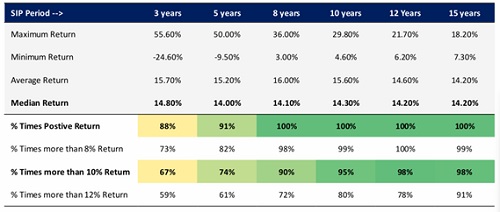Midcap segment can be a good SIP Option: WhiteOak Capital MF

WhiteOak Capital AMC has released a note on SIP titled, ‘SIP Analysis Report’. According to the fund house, the mid-cap segment is a good investment option for investors seeking to invest via the long-term SIP route. It sighted that midcap segments may offer many opportunities for potential higher growth.
Largecap, Midcap or Smallcap SIP?

An average Large Cap stock is generally less volatile than an average Small and Midcap stock and provides stability to the portfolio. However, The Nifty Midcap 150 TRI delivered strong and consistent performance, with average and median returns of 17.4% and 17.9%, respectively. It also recorded 100% positive returns and outperformed peers, delivering returns above 10% in 98% of instances and above 12% in 95% and above 15% in 79% of periods. The study reveals that, among the three market cap segments, the midcap segment is a good investment option for investors seeking to invest via the long-term SIP route.
For illustration purpose only. 10 Year Monthly Rolling (% XIRR) Return considered from August 1996 to September 2025, first observation recorded on 1-Apr-15. Past performance may or may not be sustained in future. Index performance does not signify scheme performance.
Is it better to keep changing the lane and switch to better-performing index every year?
The case study talks about an investor who had started SIP in the Mid Cap Index and annually switched it to the best-performing index of the previous year. The final XIRR percentage for this investor would have been 15.24% (as of 30-Sep-2025). Conversely, if the investor had continued SIP with the Mid Cap Index only without switching, the XIRR percentage would have been 17.30% (as of 30-Sep-2025).

If looked at 10 Years Rolling SIP Return, the average XIRR for SIP continued in Mid Cap Index is 17.43%, as against XIRR of 15.62% for investor who started SIP in Mid Cap Index and switched based on previous year best-performing index.
Large Cap Index, Mid Cap Index and Small Cap Index are represented by Nifty 100 TRI, Nifty Midcap 150 TRI and Nifty Smallcap 250 TRI respectively. 10 year rolling SIP return period is from 1 Apr 2005 to 30th September 2025 (i.e. first observation: 1 Apr 2015). Investors are requested to note that, mean returns (calculated by taking mean of 10-year rolling returns between 01/06/13 and 30/05/23) for Sensex is 12.64% and for Nifty 50 is 12.93% (Source: AMFI). Past performance may or may not be sustained in future and is not a guarantee of any future returns. Index performance does not signify scheme performance.
The calculations given do not consider stamp duty/levy etc. for ease of calculation and the values shown are pre-tax. Investors may incur tax liability on capital gains based on prevailing tax laws. Any calculations made are approximations meant for understanding a particular concept only. These calculations/views alone are not sufficient and should not be used for the developing or implementing an investment strategy. Investors should consult their financial advisers if in doubt about whether the product is suitable for them.
What is an ideal investment time horizon for SIP?
Experts often suggest investing for the “Long-term,” but what exactly is “Long-term”? Equities have proved to be a volatile asset class in the past. But the study reveals volatility reduces as investors increase their investment horizon.

For illustration purpose only. Above returns are %XIRR Rolling Returns on monthly basis for S&P BSE Sensex TRI for SIP between Sep 1996 to Sep 2025. Past performance may or may not be sustained in future.
Which SIP Frequency to Select?
A historical data analysis provided below suggests that, in the long term, it hardly matters if the
investor invests via Daily, Weekly, or Monthly SIP Frequency. All three frequencies end up
generating somewhat similar returns.
The key takeaway from the analysis is to focus on investing a small amount regularly for the long term.

For illustration purpose only. % XIRR for BSE SENSEX TRI for SIP between August 1996 to September 2025. SIP instalment amounts are selected in such a way, so that the total investment remains the same in all the three frequencies for better comparison. Assuming SIPs at the start of the week/month. Current Valuation as on 30-Sep-2025. Past performance may or may not be sustained in future.
As per the report from WhiteOak Capital Mutual Fund, SIP is better strategy than frequently changing lanes as constantly changing lanes can be both stressful and harmful. Therefore, investors should focus on reaching the ultimate financial goals by continuing SIP over the long term.
Above views are of the author and not of the website kindly read disclaimer




.jpg)



















